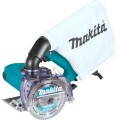Power
Rated motor power of the electric tile cutter. The more powerful the engine — the more force it can give to the cutting tool, the higher the rotation speed and disc diameter can be. Accordingly, a more
powerful tool is better suited for larger jobs and hard and/or thick materials. On the other hand, high power significantly affects the price, dimensions and weight of the tool, despite the fact that there is not always a real need for it.
In light of all this, it is necessary to choose a tile cutter in terms of power, taking into account the specifics of the intended use. So, in the case of a hand tool for simple household work, a power of 700 – 800 W is enough, more solid indicators may be required mainly for professional use. But in stationary units, where compactness does not really matter, you can not save on power — especially since such devices are usually used where performance is important.
Rotation speed
The maximum disc rotation speed provided by the motor of the electric tile cutter. Higher speeds are good for productivity, clean cuts and the ability to handle difficult materials, but they also require the right amount of power.
In general, if a tile cutter is bought for simple work with ordinary facing tiles (for example, repairs in an apartment), you can not pay much attention to this indicator: even the “slowest” models provide enough speed to cope with such tasks. But for cutting specific materials (for example, some types of stone), higher speeds may be required; detailed recommendations on this issue can be found in special sources.
Bore diameter
The diameter of the mounting hole on the cutting disc that the tile cutter is compatible with. This parameter is important when searching for and purchasing interchangeable working nozzles: the diameters of the mounting hole on the tile cutter and on the disk must match.
Cutting depth
The greatest depth to which the tool can cut through the material being processed, in other words, the maximum thickness of the tile that the tile cutter is guaranteed to be able to cut.
It is worth choosing a tool for this parameter taking into account the thickness of the material with which to work, plus some margin “just in case”. But this margin should not be too large: for a
deep cut, large discs and high power are required, which accordingly affects the price, weight and dimensions of the tool.
Water cooling
The presence in the design of the electric tile cutter
of a system for supplying water to the disc.
Water supplied directly to the cutting point plays several roles: it cools the cutter and tile, reduces friction at the point of contact, and also precipitates the dust generated during operation. This reduces the risk of cracks and chips, provides a neat and even cut, allows you to cut thin strips of material, and also has a positive effect on the life of the blade and the entire tool. The supply of water, usually, is in its own tank installed on the tile cutter.
Mitre cutting
The possibility of making oblique cuts in the tile — at an angle from the vertical. This feature can be useful, for example, when preparing corner joints.
This function is found exclusively in electric tools (see "Type"), and the angle of inclination, usually, can vary from 0° to 45°. In portable models, this angle is set by tilting the sole, and in stationary models, by the guide rail or the tabletop itself (depending on the direction of the disk feed). The tilt mechanism is often equipped with a goniometric scale, which makes the task even easier.
Vacuum cleaner connection
The ability to connect a vacuum cleaner to the tile cutter requires the presence of a special pipe, to which the hose is connected. Thanks to this, the amount of debris can be significantly reduced: most of the dust generated during cutting will be drawn in by the vacuum cleaner.
Noise level
The average noise level produced by the tile cutter during operation. Actual figures may differ from those claimed in any direction, depending on the specific material, speed of work, wear of the cutting blade, etc. However, in general, according to this indicator, it is quite possible to evaluate the loudness of the unit.
The lower the noise level, the more comfortable the work with the tile cutter, the lower the fatigue. The quietest of modern instruments give out about 60 dB — this is the level of a loud conversation at a distance of about 1 m; in the most noisy, the volume exceeds 100 dB (sound background in an industrial workshop).

